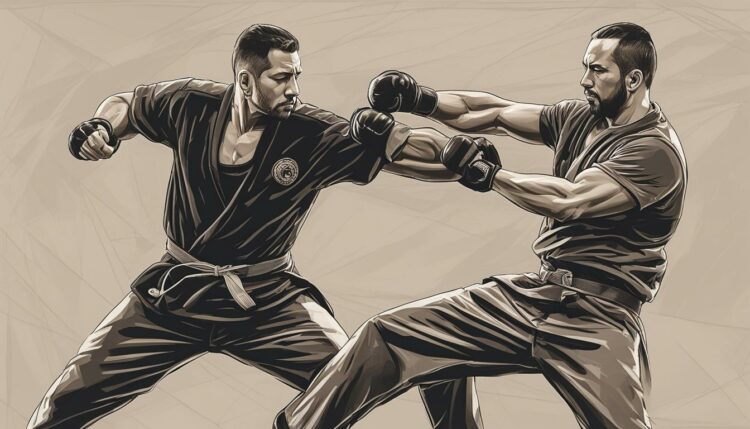Krav Maga, a self-defense system developed for actual combat, incorporates various techniques, including joint locks.
While joint locks are commonly used in martial arts like Aikido, Hapkido, and Brazilian Jiu-Jitsu, Krav Maga also utilizes joint locks to control opponents and disarm aggressors.
Joint locks involve applying pressure on a joint, such as an arm or wrist, to restrict an attacker’s movement or cause them to submit due to pain or the risk of injury.
However, it’s essential to practice joint locks under the guidance of a trained instructor and prioritize safety in all martial arts techniques.
Joint Locks in Krav Maga: Applicable Techniques
Regarding self-defense systems like Krav Maga, joint locks are crucial in controlling opponents and neutralizing threats.
In Krav Maga, joint locks are applied through various techniques that target vulnerable joints such as the wrist, arm, shoulder, and more. These techniques are designed to restrict an attacker’s movement, cause them to submit due to pain, or disarm them effectively.
Applying joint locks in Krav Maga requires a deep understanding of human anatomy and the ability to exploit weak points in an assailant’s body.
From defending against grabs and chokes to countering strikes, practitioners employ joint manipulation techniques to gain control over their attackers.
However, it’s important to note that these techniques should only be used in necessary self-defense situations and with proper training and caution.
One of the primary goals of joint locking techniques in Krav Maga is to subdue an attacker while minimizing harm to both parties involved. By utilizing their knowledge of joint mechanics, Krav Maga practitioners can effectively neutralize an aggressor without resorting to excessive force.
It’s essential to prioritize safety and responsibility when practicing joint locks, always under the guidance of a trained instructor.
| Joint Lock Technique | Application | Effectiveness |
|---|---|---|
| Wrist Lock | Defending against grabs and wrist control | Restricts movement and causes pain |
| Arm Lock | Counterattacks and disarming techniques | Immobilizes the attacker and controls their weapon |
| Shoulder Lock | Defenses against arm strikes and holds | Disables the attacker’s upper body and restricts movement |
| Leg Lock | Neutralizing kicks and defending against takedowns | Controls and immobilizes the attacker’s lower body |
As with any martial arts technique, joint locks in Krav Maga should be used with the utmost caution and only when necessary for self-defense. It’s crucial to develop proper technique through regular training and always to prioritize the safety of oneself and others.
Krav Maga Techniques for Joint Locks: Submission and Self-Defense
Within the realm of Krav Maga, practitioners learn various self-defense techniques that involve joint locks. These techniques are designed to subdue attackers and protect oneself in real-life combat situations.
In Krav Maga, joint lock submissions are taught with precision and caution. Practitioners are trained to manipulate an assailant’s joints, applying pressure in specific ways to gain control or force them into submission. These techniques encompass a range of joint locks, including wrist locks, arm bars, shoulder locks, and leg locks.
The effectiveness of these joint-locking techniques lies in their ability to neutralize threats quickly and efficiently. By exploiting vulnerable joints in the human body, practitioners can subdue attackers while minimizing the risk of causing severe injury.
However, it’s essential to note that these techniques should only be used in genuine self-defense situations.
Krav Maga instructors emphasize the responsible and ethical use of joint locks, ensuring practitioners understand the potential consequences of their actions. Proper training and guidance from a qualified instructor are crucial to mastering and using these techniques safely.
FAQ
Does Krav Maga Use Joint Locks?
Yes, joint locks are incorporated into Krav Maga’s self-defense system. They are used to control opponents and disarm aggressors.
What other martial arts use joint locks?
Martial arts such as Aikido, Hapkido, and Brazilian Jiu-Jitsu also commonly utilize joint locks as part of their techniques.
How do joint locks work in Krav Maga?
Joint locks involve applying pressure on a joint, such as an arm or wrist, to restrict an attacker’s movement or cause them to submit due to pain or the risk of injury.
Should I practice joint locks without guidance?
No, it is essential to practice joint locks under the guidance of a trained instructor to ensure proper technique and prioritize safety.
Can joint locks be used for self-defense in various situations?
Yes, joint locks can be applied in scenarios such as defending against grabs, chokes, and strikes in Krav Maga.
What techniques are there in Krav Maga for joint locks?
Krav Maga teaches various joint-locking techniques, including wrist locks, arm locks, shoulder locks, and joint control tactics.
Are joint locks effective in neutralizing threats and maintaining personal safety?
Yes, by understanding the anatomy of the human body and exploiting vulnerable joints, Krav Maga practitioners can effectively control and subdue assailants.
Can joint locks be used outside of self-defense situations?
Joint locks should only be used in self-defense and with proper training and caution. Their use should be limited to genuine self-defense scenarios.
